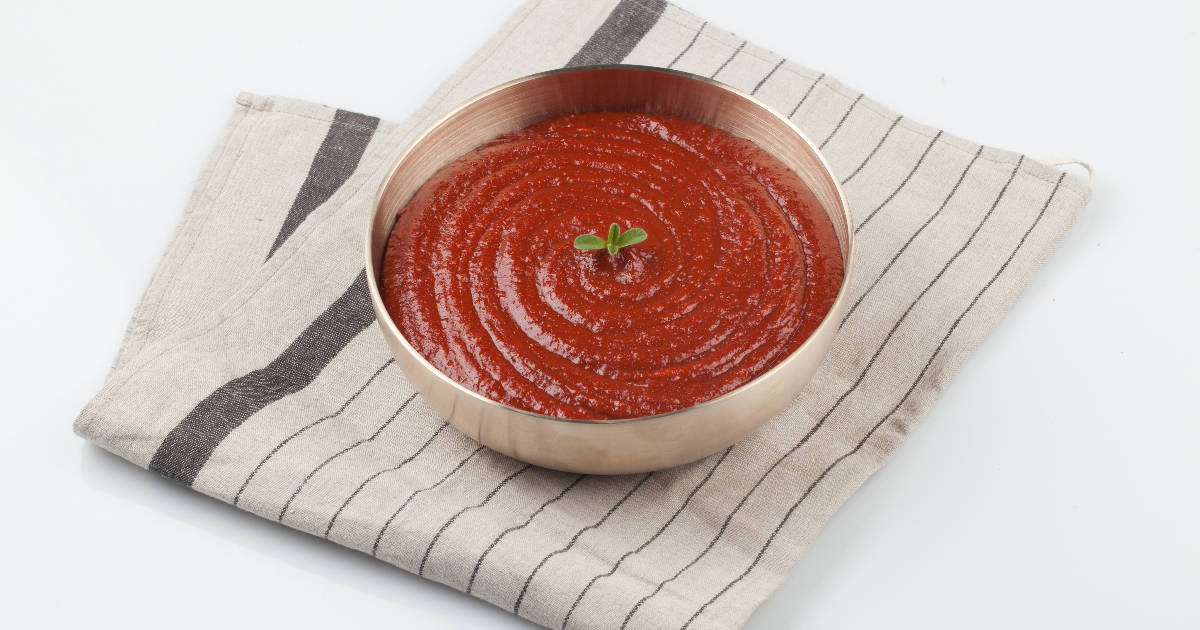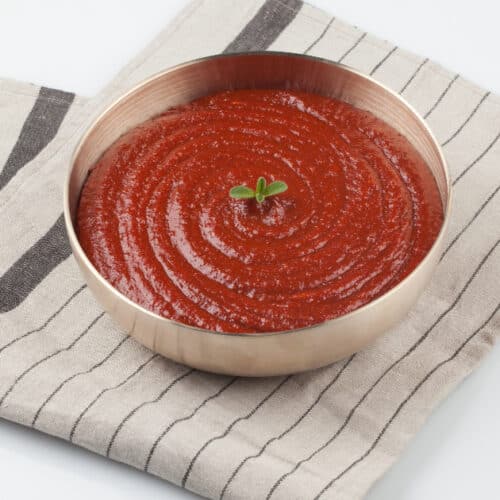Gochujang ketchup is the latest condiment craze for good reason - it adds a sweet heat and umami depth to everything it touches. This Korean-inspired ketchup starts with the familiar tomato flavor of traditional ketchup, then gets amped up with the addition of gochujang, a fermented Korean chili paste.

Gochujang brings a complex, almost addictive flavor from its key ingredients of glutinous rice, fermented soybeans, and chili peppers. The fermentation process mellows the chili heat and develops rich, caramel-like notes. When blended into ketchup, gochujang transforms it from basic to bold and crave-worthy.
This spicy ketchup works well as a dipping sauce, drizzled over burgers or fries, or even swirled into Asian noodle dishes. The recipe is endlessly adaptable to suit your preferred level of heat. Let's dive in to learn how to make gochujang ketchup at home.
blending the sauce
Making your own gochujang ketchup allows you to customize the flavor to your tastes. You control the quantity of chili paste, bringing as much or as little heat and smokiness as you like.
The core ingredients are easy to find:
- Ketchup provides the classic tomato tang
- Gochujang brings umami depth and slow-burn heat
- Soy sauce adds extra savoriness
- Brown sugar balances with a subtle sweetness
- Garlic, ginger, and sesame give an aromatic fragrance
Start by whisking everything together in a small bowl until thoroughly blended. For best results, allow the flavors to meld for at least an hour in the refrigerator before serving.
Store leftover sauce in an airtight container in the fridge for up to two weeks. The colors will darken over time as the ingredients mingle, resulting in an even deeper, more complex flavor.
Enhancing any meal
A bowl of gochujang ketchup can single-handedly upgrade any meal. Its versatility makes it a staple worth keeping on hand. The sauce complements both Asian-inspired dishes and American favorites.
Snacks and starters
Jazz up snack time by dipping fries, chicken tenders, potstickers, egg rolls, or wontons into this sauce. It also shines as a dip for fresh raw veggies like carrots, jicama, bell peppers, or cucumbers.
For a party appetizer, mix gochujang ketchup with mayo or Greek yogurt for quick chicken wings or meatballs. It also makes baked potato skins next level.
Burgers and sandwiches
Slather gochujang ketchup on your next burger to add tangy heat. For a flavor twist, brush the sauce onto fish fillets or chicken breasts before grilling or baking. Add it to any sandwich or wrap that needs a flavor boost.
Noodles and rice bowls
Transform plain noodles or rice into something special by incorporating gochujang ketchup. Toss it with ramen, udon, soba, or cellophane noodles. Stir it into fried rice or bibimbap. Mix it into cold sesame noodles for a flavor punch.
Pizzas and bakes
Take your next pizza to new heights by drizzling gochujang ketchup over the finished pie instead of regular tomato sauce. Or add a spoonful to chili or pasta bakes for extra depth.
Saucing meat
Flavor up roast chicken, pork tenderloin, or meatloaf by brushing with gochujang ketchup during baking. It also livens up grilled dishes like chicken skewers, pork chops, or steak.
Dipping sauces
Many popular fried foods get even better with spicy ketchup for dipping. It's fantastic with tempura, eggplant fries, falafel, fried pickles, and more. For a quick snack, use it to dress up store-bought frozen options like chicken nuggets.
On the table
Offer bottles of gochujang ketchup on the dinner table to spice up every meal. Let family members shake it on anything they please for a little DIY fun. Set out ramekins of the sauce for dipping veggies, dumplings, spring rolls, or other appetizers.
Boosting the heat
The joy of making your own gochujang ketchup is tailoring the spiciness to suit your tastes. Follow these tips to amp up the slow-burning heat:
- Increase the amount of gochujang - Start with 1 tablespoon per 1/2 cup ketchup and add more until it reaches your desired level of chili flavor.
- Add gochugaru flakes - These dried Korean chili flakes pack a punch. Sprinkle up to 1 tablespoon into the sauce.
- Mix in sambal oelek - This Southeast Asian chili garlic sauce brings searing heat. Add starting with 1/2 teaspoon.
- Include minced fresh chilies - Jalapenos, serranos, and other hot peppers contribute fresh chili flavor.
- Splash in sriracha - For more garlic notes and vinegary bite, blend in up to 1 tablespoon of rooster sauce.
- Finish with chili oil - Drizzle in flavored oil made from dried chilies for lingering heat.
- Garnish with flaky sea salt - The salty crystals add tons of flavor.
Experiment to create your ideal balance of sweet, tangy, and spicy. Just keep in mind that the gochujang flavor will intensify over time.
Serving suggestions
A few final tips for getting the most out of your homemade gochujang ketchup:
- Shake it up - Store the ketchup in a squeeze bottle to easily drizzle over anything.
- Get creative - Use it anywhere you'd normally use ketchup or hot sauce for an instant flavor upgrade.
- Try it on eggs - Spice up your next omelet or fried egg with this sauce.
- Make a glaze - Brush onto chicken wings, meatballs, or pork ribs while roasting or grilling for finger-licking results.
- Mix with mayo - Combine with mayonnaise or Greek yogurt to make a quick spicy aioli.
- Top it off - Finish any dish with a dollop of gochujang ketchup, from noodle bowls to tacos.
With these serving ideas, you'll never see ketchup the same way again. The next time you crave an extra flavor kick, look no further than gochujang ketchup. This sweet, spicy condiment can transform your favorite foods from basic to bold and irresistible.
Frequently Asked Questions
What does gochujang ketchup taste like?
Gochujang ketchup has a sweet, tangy, and spicy flavor. The gochujang adds earthy, fermented notes plus a slow-building heat. When blended into ketchup it creates a complex, moreish sauce, unlike regular ketchup.
Is gochujang ketchup spicy?
It can be! The spiciness depends on the amount of gochujang added. Start with 1-2 tablespoons of gochujang per 1/2 cup ketchup, then adjust up or down to your desired level of heat.
What's the best way to use gochujang ketchup?
Use it anywhere you'd normally use ketchup or hot sauce - burgers, sandwiches, fries, fried foods, eggs, grilled meats, etc. It's also great in stir-fries, noodle dishes, rice bowls, or as a dipping sauce.
How long does homemade gochujang ketchup last?
Stored in an airtight container in the fridge, gochujang ketchup will be kept for up to 2 weeks. The flavors continue to develop and meld during storage.
Can I use sriracha instead of gochujang?
You can, but the flavor will be different. Sriracha has more garlic and vinegar notes, while gochujang is earthier and sweeter. For best results, use real Korean gochujang.
What goes well with gochujang ketchup?
It complements starchy foods like fries, tots, and potato chips. It's also great with fried foods like tempura, falafel, calamari, etc. Burger patties, grilled meats, and roasted vegetables love a drizzle of this ketchup too.
Conclusion
Gochujang ketchup is your new secret weapon for making any meal more crave-worthy.
So get creative with all the ways you can shake up this versatile sauce.
A delicious world of flavor awaits when you open up a bottle of your homemade ketchup blended with the complex goodness of gochujang.
Your food will never taste the same again once you incorporate this simple yet ingenious recipe into your regular rotation.

Sweet and Spicy Korean Ketchup
Ingredients
- 1/2 cup ketchup
- 2 tablespoons gochujang (can add more to taste)
- 2 tablespoons brown sugar
- 1 tablespoon soy sauce
- 1 teaspoon minced garlic
- 1 teaspoon grated fresh ginger
- 1/2 teaspoon sesame oil
Instructions
- In a small bowl, whisk together all of the ingredients until thoroughly blended.
- Allow flavors to meld for at least 1 hour in the refrigerator before serving.
- Store leftover ketchup in an airtight container in the refrigerator for up to 2 weeks.
Notes
- Adjust gochujang amount to suit your desired spice level.
- For extra heat, add gochugaru flakes, sambal oelek, minced fresh chilies, sriracha, or chili oil.
- Try using it as a dip, stirred into noodle dishes, as a sandwich spread, drizzled over pizza, or as a marinade.

